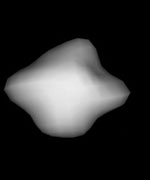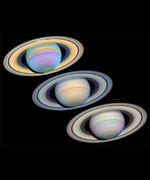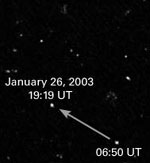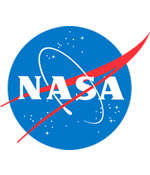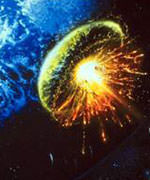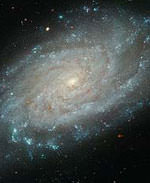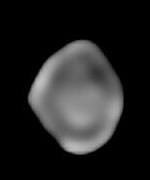
Image credit: Keck
A team of astronomers have used the 10-metre Keck II telescope to create a series of images that show asteroid (511) Davida from every angle. The images of the 320 km asteroid were taken in late December, 2002 using the Keck’s adaptive optics system – a special technology that allows the telescope to compensate for distortion caused by the Earth’s atmosphere. The observations are so precise that features as small as 46 km can be seen on the surface of the asteroid.
A team of scientists from the W.M. Keck Observatory and several other research institutions have made the first full-rotational, ground-based observations of asteroid (511) Davida, a large, main-belt asteroid that measures 320 km (200 miles) in diameter. These observations are among the first high-resolution, ground-based pictures of large asteroids, made possible only through the use of adaptive optics on large telescopes. This research will help improve understanding of how asteroids were formed and provide information about their compositions and structures. Because the asteroids were formed and shaped by collisions, a process that also affected the Earth, Moon, and planets, these studies will also help astronomers understand the history and evolution of the solar system.
” Asteroid Davida was discovered 100 years ago, but this is the first time anyone has been able to see this level of detail on this object,” said Dr. Al Conrad, scientist at the W.M. Keck Observatory. “With adaptive optics, we’re finally able to transform asteroids like Davida from a single, faint point-source into an object of true geological study.”
Ground-based observations of large, main-belt asteroids are made possible only through a powerful astronomical technique called adaptive optics, which removes the blurring caused by Earth’s atmosphere. Without adaptive optics, critical surface information and details about the asteroid’s shape are lost. The techniques used at the W.M. Keck Observatory allow astronomers to measure the distortion of light caused by the atmosphere and rapidly make corrections, restoring the light to near-perfect quality. Such corrections are most easily made to infrared light. In many cases, infrared observations made with Keck adaptive optics are better than those obtained with space-based telescopes.
The observations of asteroid (511) Davida were made with the 10-meter (400-inch) Keck II telescope on December 26, 2002. Images were taken over a full rotation period of about 5.1 hours, just a few days before its closest approach to Earth. At that time, Davida’s angular diameter was less than one-ten-thousandth of a degree, about the size of a quarter as seen from a distance of 18 kilometers (11 miles). The high angular resolution allowed astronomers to see surface details as small as 46 kilometers (30 miles), about the size of the San Francisco Bay area. The next time Davida comes this close to Earth will be in the year 2030.
At the time of the observations, Davida?s north pole faced Earth. While scientists could see the asteroid spinning, only the northern hemisphere was visible. Yet the profile of the asteroid is far from circular: At least two flat facets can be seen on its surface. Although scientists knew previously from light variations that Davida must have an oblong shape, details of that shape were not available until now. Initial evaluation of the images reveal some dark features, and scientists are still working to understand to what extent these are surface markings, topographical features, or artifacts of the image processing.
” Adaptive optics on large telescopes is allowing us to make detailed studies from the ground that were previously impossible or prohibitively expensive,” said Dr. William Merline, principal scientist with the Southwest Research Institute, and a participant in this research. “We can now make observations that once required either the scarce resources of space telescopes or spacecraft missions to asteroids. While these space telescopes and space missions are still needed for complete study of the asteroids, ground-based observations such as these will help tremendously in planning the mission observations and focusing the resources where they will be most effective.”
Asteroids are the collection of rocky objects orbiting between Mars and Jupiter. They were likely prevented from forming into a planet, partly due to Jupiter’s massive gravitational influence.
? Although the asteroids began their lives colliding gently, in a way that would lead them eventually to form a planet, Jupiter’s gravity eventually stirred up their orbits, and they began to collide at higher speeds,? added participant Dr. Christophe Dumas, planetary astronomer with the Jet Propulsion Laboratory. ?These collisions tended to cause them to break up rather than gently stick together. The resulting fragments, numbering in the hundreds of thousands, are the asteroids we see today. They collide with each other and have impacted the Earth, Moon, and planets over time. One need only look at the scarred surface of our Moon to see the cumulative result. Study of the asteroid’s shape, size, and surface features helps us understand how these collisions operate and thus how our planet was, and still is, being affected by these impacts.?
Observations of the shapes of asteroids, such as those released today, can tell us about the types and severity of impacts that occurred, and possibly also give clues into the overall structure of an asteroid — for example, whether it may be solid rock, or a jumble of smaller rocks. Surface features can reveal a history of large impacts or variations in the composition that should, in turn, further help us understand the asteroid’s history.
Asteroid (511) Davida was discovered by R. S. Dugan in 1903 in Heidelberg, Germany. The (511) in Davida’s name means it was the 511th asteroid to be discovered and included in the list of asteroids maintained by the International Astronomical Union.
Team members responsible for the observations are Al Conrad, David Le Mignant, Randy Campbell, Fred Chaffee, Robert Goodrich, Shui Kwok of the W.M. Keck Observatory; Christophe Dumas, Jet Propulsion Laboratory; William Merline, Southwest Research Institute; Heidi Hammel, Space Science Institute; and Thierry Fusco, Onera, France.
The W.M. Keck Observatory is operated by the California Association for Research in Astronomy, a scientific partnership of the California Institute of Technology, the University of California, and the National Aeronautics and Space Administration.
Source: Keck Press Release
